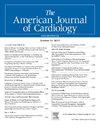Outcomes of Percutaneous Coronary Interventions Following Transcatheter Aortic Valve Replacement: Insights From the CathPCI Registry
IF 2.1
3区 医学
Q2 CARDIAC & CARDIOVASCULAR SYSTEMS
引用次数: 0
Abstract
Although transcatheter aortic valve replacement (TAVR) devices can impair coronary access, there are limited real-world data comparing outcomes of percutaneous coronary intervention (PCI) in post-TAVR versus non-TAVR patients. In this study, we compare procedural characteristics and outcomes between patients with versus without a history of TAVR who undergo PCI. We used claims data for the Medicare population to evaluate the incidence of PCI after TAVR between 2011 and 2017. Then, using the CathPCI Registry, we compared PCI outcomes between patients with a history of TAVR versus propensity score-matched non-TAVR patients. Of the 52,780 Medicare patients who underwent TAVR between 2011 and 2017, the incidence of acute myocardial infarction (AMI) was 10.2% and of PCI was 5.1% at 5 years. At 5 years, the incidence of stroke was 5.0% and of death was 64.0%. In the CathPCI Registry, procedural success for PCI was similar between 1,309 post-TAVR patients versus 5,236 propensity-score matched patients without prior TAVR. However, post-TAVR patients required greater fluoroscopic time (21.9 vs 17.7 minutes, p <0.001) and had higher rates of post-procedural stroke (0.8% vs 0.4%, p = 0.02) and bleeding (5.1% vs 2.9%, p <0.001). Post-TAVR patients were more likely to have repeat PCI in the 3 years post-PCI (HR: 1.36, 95% C.I: 1.09, 1.70) and had higher rates of stroke (HR: 1.65, C.I.: 1.07 to 2.56, p = 0.023) and death (HR: 1.23, C.I.: 1.11-1.38, p <0.001) compared to non-TAVR patients. In conclusion, in the CathPCI Registry, patients with a history of TAVR appeared to have similar procedural success but longer fluoroscopic times, more frequent post-procedural bleeding and stroke, and a higher likelihood of a repeat PCI compared with matched patients without a history of TAVR.
经导管主动脉瓣置换术后经皮冠状动脉介入治疗的结果:来自CathPCI登记的见解。
尽管经导管主动脉瓣置换术(TAVR)装置会损害冠状动脉通路,但比较TAVR术后与非TAVR患者经皮冠状动脉介入治疗(PCI)结果的真实数据有限。在这项研究中,我们比较了有TAVR病史和没有TAVR病史的患者接受PCI治疗的程序特征和结果。我们使用医疗保险人群的索赔数据来评估2011-2017年TAVR后PCI的发生率。然后,使用CathPCI Registry,我们比较了有TAVR病史的患者与倾向评分匹配的非TAVR患者之间的PCI结果。在2011-2017年期间接受TAVR的52780名医疗保险患者中,5年时急性心肌梗死(AMI)的发生率为10.2%,PCI的发生率为5.1%。5年时,卒中发生率为5.0%,死亡率为64.0%。在CathPCI Registry中,1309例TAVR后患者与5236例倾向评分匹配的无TAVR患者的PCI手术成功率相似。然而,tavr后患者需要更长的透视时间(21.9 vs 17.7分钟,p
本文章由计算机程序翻译,如有差异,请以英文原文为准。
求助全文
约1分钟内获得全文
求助全文
来源期刊

American Journal of Cardiology
医学-心血管系统
CiteScore
4.00
自引率
3.60%
发文量
698
审稿时长
33 days
期刊介绍:
Published 24 times a year, The American Journal of Cardiology® is an independent journal designed for cardiovascular disease specialists and internists with a subspecialty in cardiology throughout the world. AJC is an independent, scientific, peer-reviewed journal of original articles that focus on the practical, clinical approach to the diagnosis and treatment of cardiovascular disease. AJC has one of the fastest acceptance to publication times in Cardiology. Features report on systemic hypertension, methodology, drugs, pacing, arrhythmia, preventive cardiology, congestive heart failure, valvular heart disease, congenital heart disease, and cardiomyopathy. Also included are editorials, readers'' comments, and symposia.
 求助内容:
求助内容: 应助结果提醒方式:
应助结果提醒方式:


